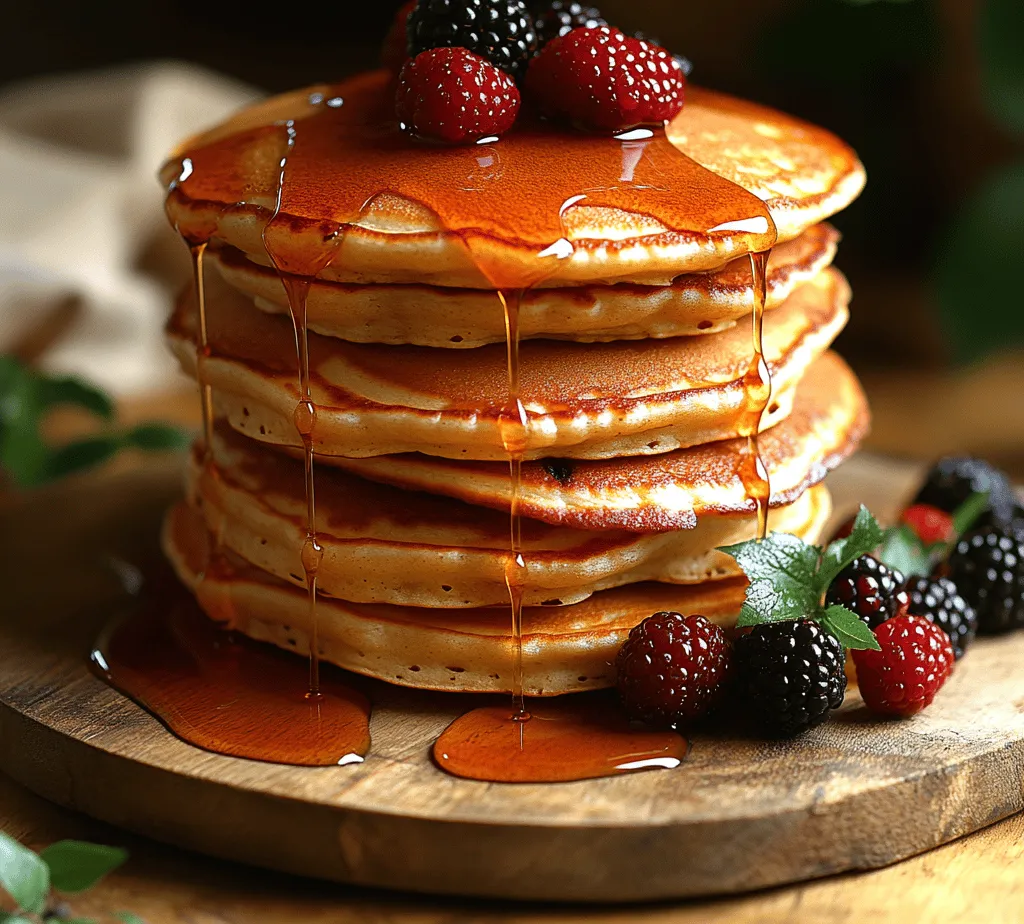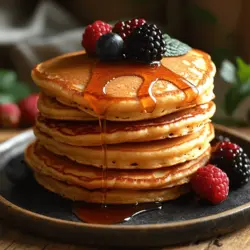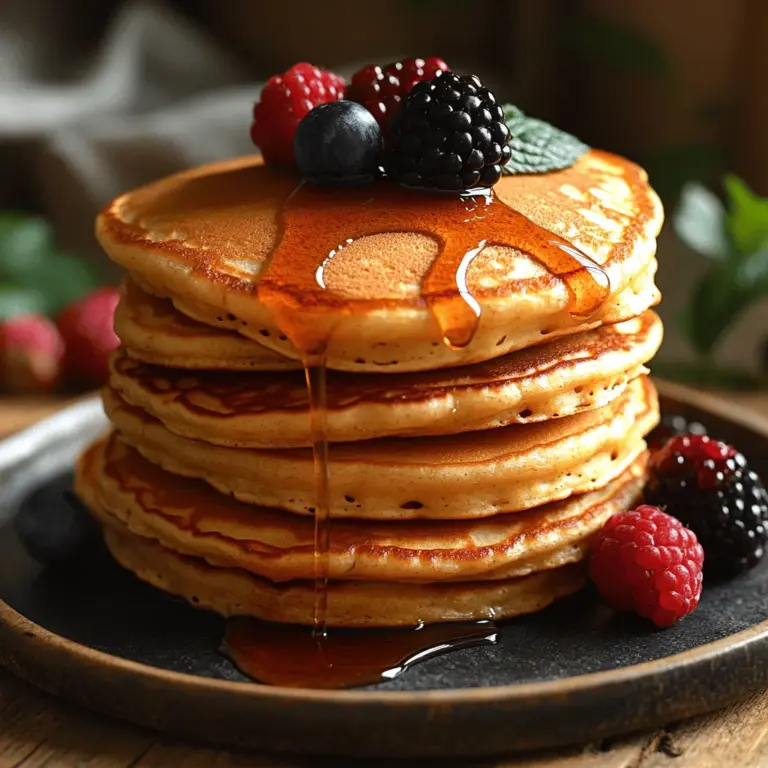Introduction
Delight in the morning with a stack of Heavenly Fluffy Buttermilk Pancakes. These pancakes are not just any breakfast dish; they are a fluffy, airy treat that combines the tanginess of buttermilk with a perfect blend of ingredients to create a mouthwatering experience. In this article, we will explore the art of pancake making, the science behind the ingredients, and tips to elevate your breakfast game. Whether you’re an experienced chef or a beginner in the kitchen, this recipe promises to bring joy to your table.
Pancakes have long been a beloved breakfast staple, cherished for their comforting texture and versatility. They can be dressed up with fruits, nuts, or syrups, or simply enjoyed as they are. What sets this recipe apart is the use of buttermilk, which not only adds a unique flavor but also contributes to the pancakes’ remarkable fluffiness. As you whip up a batch of these pancakes, you’ll discover that they are light, tender, and utterly indulgent.
Buttermilk pancakes are often associated with cozy family breakfasts, weekend brunches, and even special occasions. The comforting aroma that fills your kitchen as they cook is a precursor to the deliciousness that awaits. In the following sections, we will delve deeper into the ingredients that make these pancakes so special and guide you through the preparation steps to ensure your pancakes turn out perfectly every time.
Understanding the Ingredients
Exploring the Role of Each Ingredient
All-Purpose Flour: The Foundation of Pancake Batter
The main ingredient that gives pancakes their structure is all-purpose flour. This versatile ingredient contains the right balance of protein and starch, which helps create a tender yet sturdy pancake. The flour acts as the backbone of the batter, allowing it to hold together while still being light and fluffy.
Granulated Sugar: Adding Sweetness and Flavor
Granulated sugar is not just for sweetness; it also enhances the flavor of the pancakes. Sugar caramelizes during cooking, contributing to the golden-brown color and adding depth to the overall taste. It’s important to use the right amount—too little may result in bland pancakes, while too much can lead to overly sweet results.
Baking Powder and Baking Soda: The Leavening Agents for Fluffiness
Baking powder and baking soda are essential for achieving that cloud-like fluffiness we all love in pancakes. Baking powder, a combination of an acid and a base, releases carbon dioxide when it comes into contact with liquid and heat, creating bubbles that lift the batter. Baking soda, on the other hand, requires an acid (like buttermilk) to activate. Together, these two leavening agents work in harmony to create the perfect rise.
Salt: Enhancing Flavors
Salt is often overlooked in sweet recipes, but it plays a crucial role in balancing flavors. Just a pinch of salt can elevate the overall taste of the pancakes, bringing out the sweetness and enhancing the richness of the buttermilk and butter.
Buttermilk: The Secret to Tenderness and Flavor
Buttermilk is the star ingredient in this recipe. Its acidity reacts with the baking soda and baking powder, contributing to the leavening process while also imparting a slightly tangy flavor that balances the sweetness of the pancakes. Additionally, buttermilk adds moisture and tenderness, ensuring your pancakes are light and fluffy.
Eggs: Binding the Ingredients and Adding Richness
Eggs serve multiple purposes in pancake batter. They act as a binder, holding the ingredients together, while also adding richness and flavor. The proteins in eggs help with structure, ensuring that your pancakes hold their shape while remaining soft and tender.
Unsalted Butter: For Moisture and Flavor
Unsalted butter is the source of moisture and flavor in pancake batter. Using unsalted butter allows you to control the amount of salt in your recipe, ensuring a well-balanced flavor. The butter also contributes to the pancakes’ rich taste and golden color when cooked.
Vanilla Extract: A Hint of Aromatic Sweetness
A splash of vanilla extract adds a delightful aromatic sweetness to your pancakes. While it’s optional, this ingredient can elevate the flavor profile, making your pancakes even more irresistible. Choose a high-quality vanilla extract for the best results.
Preparation Steps for Heavenly Fluffy Buttermilk Pancakes
Now that we understand the essential ingredients that contribute to our Heavenly Fluffy Buttermilk Pancakes, it’s time to gather everything you need for preparation.
Gathering Your Ingredients
Before you start cooking, it’s important to have all your ingredients ready. Here’s a list of what you’ll need:
– 1 cup all-purpose flour
– 2 tablespoons granulated sugar
– 1 teaspoon baking powder
– 1/2 teaspoon baking soda
– 1/4 teaspoon salt
– 1 cup buttermilk (at room temperature)
– 1 large egg (at room temperature)
– 2 tablespoons unsalted butter (melted and slightly cooled)
– 1 teaspoon vanilla extract (optional)
Essential Tools and Equipment Needed
To make the process smoother, gather the following kitchen tools:
– Mixing bowls: You’ll need one for dry ingredients and another for wet ingredients.
– Whisk: For mixing ingredients thoroughly.
– Measuring cups and spoons: Accurate measurements are key to perfect pancakes.
– Non-stick skillet or griddle: A flat cooking surface ensures even cooking.
– Spatula: For flipping the pancakes without breaking them.
Importance of Room Temperature Ingredients
Using room temperature ingredients is crucial for achieving the best texture in your pancakes. Cold buttermilk and eggs can lead to a lumpy batter, which may not rise properly. Before you start mixing your ingredients, take them out of the refrigerator to allow them to warm up slightly.
Mixing the Dry Ingredients
The first step in preparing your pancake batter is to combine the dry ingredients.
Why Proper Mixing is Crucial for Texture
Mixing the dry ingredients well ensures that the leavening agents are evenly distributed throughout the flour. This uniformity is essential for consistent pancake texture and rise.
Tips for Measuring Flour Accurately
To measure flour accurately, it’s best to use the spoon-and-level method. Instead of scooping flour directly from the bag, use a spoon to lift the flour into your measuring cup, then level it off with a straight edge (like the back of a knife). This prevents compacting the flour, which can lead to dense pancakes.
1. In a medium bowl, whisk together the all-purpose flour, granulated sugar, baking powder, baking soda, and salt until well combined.
2. Set the dry mixture aside as you prepare the wet ingredients.
Combining Wet Ingredients
Next, it’s time to prepare the wet ingredients, which will be combined with the dry mixture to create the pancake batter.
The Significance of Buttermilk and Eggs at Room Temperature
As mentioned earlier, using room temperature buttermilk and eggs is vital for a smooth batter. Cold ingredients can lead to clumps and uneven cooking, so take a moment to ensure they are at room temperature.
How to Properly Melt Butter Without Burning
To melt butter without burning it, place it in a microwave-safe bowl and heat it in short intervals of 10-15 seconds, stirring in between. Alternatively, you can melt it on the stovetop over low heat, watching it closely to avoid browning.
1. In a separate bowl, whisk together the buttermilk, egg, melted butter, and vanilla extract (if using) until smooth and well combined.
2. Once mixed, pour the wet ingredients into the bowl with the dry ingredients.
Folding Technique for the Perfect Batter
Now comes one of the most important steps in creating the perfect pancake batter—mixing the ingredients together.
Understanding the Importance of Not Overmixing
When combining the wet and dry ingredients, it’s crucial to mix just until combined. Overmixing can lead to gluten development, resulting in tough pancakes. A few lumps in the batter are perfectly fine; they will disappear as the pancakes cook.
Identifying the Right Consistency for Pancake Batter
The ideal pancake batter should be thick but pourable. It should be able to drop from a spoon but not be too runny. If the batter seems too thick, you can add a splash of buttermilk to reach the desired consistency.
1. Using a spatula or wooden spoon, gently fold the wet ingredients into the dry ingredients until just combined. Be careful not to overmix.
2. Let the batter rest for about 5-10 minutes. This resting time allows the flour to absorb the liquid, resulting in even fluffier pancakes.
The Cooking Process
With your pancake batter ready, it’s time to move on to the cooking process.
Prepping the Cooking Surface
Before pouring the batter onto the cooking surface, it’s important to prepare it properly.
1. Preheat your non-stick skillet or griddle over medium heat. To test if it’s ready, sprinkle a few drops of water onto the surface; if they sizzle and evaporate immediately, it’s time to start cooking.
2. Lightly grease the skillet with a small amount of butter or cooking spray to prevent sticking.
As you prepare to cook your Heavenly Fluffy Buttermilk Pancakes, remember that the right cooking surface and temperature are key to achieving that golden-brown exterior while keeping the inside soft and fluffy.
Stay tuned for the next part of this article, where we will dive into the cooking process and share tips for serving and enjoying your delightful pancakes!

Choosing the Right Skillet or Griddle
When it comes to making Heavenly Fluffy Buttermilk Pancakes, the type of skillet or griddle you choose can make a significant difference in the cooking process. Ideally, you should use a non-stick skillet or a well-seasoned cast iron griddle. Non-stick surfaces allow for easy flipping and less chance of sticking, while cast iron provides excellent heat retention and distribution, which is essential for achieving that perfect golden-brown color.
If you’re using a non-stick skillet, ensure that it is in good condition; if the coating is scratched or damaged, it might not release the pancakes properly. For a cast iron skillet, preheat it thoroughly before adding the batter to ensure even cooking. Whichever you choose, medium to medium-low heat is usually the best setting for cooking pancakes, allowing them to cook through without burning the outsides.
Heating Tips for Even Cooking
Before pouring in your pancake batter, it’s crucial to ensure your skillet is at the right temperature. A good way to test this is to sprinkle a few drops of water onto the surface; if they sizzle and evaporate almost immediately, your skillet is ready. If the water simply sits there, it means the skillet needs more time to heat up. Conversely, if the water evaporates too quickly, your skillet might be too hot, which could lead to burnt pancakes.
Once you pour the batter into the skillet, avoid the temptation to flip the pancakes too early. Allow them to cook undisturbed, which promotes even cooking and browning.
Cooking the Pancakes
Identifying the Right Time to Flip Pancakes
One of the keys to perfect pancakes is knowing when to flip them. While cooking, look for bubbles to form on the surface of the pancake; when these bubbles start to pop and the edges appear set, it’s time to flip. Typically, this will take about 2-3 minutes per side, depending on your heat settings.
Signs of Perfectly Cooked Pancakes
Perfectly cooked pancakes will be golden brown on both sides, fluffy in texture, and will spring back when lightly pressed in the center. If the pancakes are cooked too long, they may become dry or crunchy, while undercooked pancakes can be gooey. Aim for that beautiful balance that results in soft, tender pancakes that melt in your mouth.
Keeping Pancakes Warm
There’s nothing worse than cold pancakes, so keeping them warm while you finish cooking the rest is essential. A great method is to preheat your oven to a low setting (around 200°F/90°C) and place the cooked pancakes directly onto a baking sheet in a single layer. Covering them with aluminum foil will help retain heat without drying them out. Alternatively, you can keep them warm on a plate covered with a clean kitchen towel, which allows steam to escape while preventing them from getting cold.
Serving Suggestions
Creative Toppings to Enhance Your Pancakes
While Heavenly Fluffy Buttermilk Pancakes are delicious on their own, the right toppings can elevate them to a whole new level. Here are some of the best options:
Classic Options:
– Maple Syrup: A traditional favorite, pure maple syrup adds a rich sweetness that complements the buttery flavor of the pancakes.
– Fresh Berries: Strawberries, blueberries, and raspberries not only add a burst of color but also a refreshing tang that balances out the sweetness.
– Whipped Cream: Light and airy whipped cream adds a luxurious touch, making your pancakes feel extra special.
Unique Twists:
– Nut Butters: Almond or peanut butter provides a nutty flavor and creamy texture that pairs beautifully with pancakes.
– Chocolate Chips: Sprinkle some chocolate chips into the batter for a decadent treat that both kids and adults will love.
– Flavored Syrups: Experiment with flavored syrups like blueberry, cinnamon, or caramel for an exciting twist on the classic.
Pairing Beverages with Pancakes
To round out your pancake breakfast, consider pairing your fluffy pancakes with complementary beverages:
– Coffee and Tea Recommendations: A steaming cup of coffee or a refreshing herbal tea can enhance the flavors of your pancakes. Consider a rich dark roast coffee or a smooth chai latte as perfect companions.
– Smoothies or Fresh Juice Options: For a lighter option, a fruity smoothie or a glass of fresh-squeezed orange juice can add a refreshing contrast to the richness of the pancakes.
The Science Behind Fluffy Pancakes
Understanding the science behind your ingredients can significantly improve your pancake-making skills.
Understanding the Leavening Process
The combination of baking powder and baking soda is crucial for fluffy pancakes. Baking powder contains both an acid and a base, which creates carbon dioxide gas when mixed with liquid and heated, causing the batter to rise. Baking soda, on the other hand, requires an acidic ingredient—in this case, buttermilk—to activate it. The reaction between these two leavening agents results in a light, airy texture that is characteristic of fluffy pancakes.
The Role of Buttermilk in Creating a Tender Texture
Buttermilk not only activates baking soda but also contributes to the overall texture of the pancakes. It contains lactic acid, which helps to break down gluten, leading to a more tender pancake. The acidity also enhances the flavor, providing a subtle tang that complements the sweetness of the syrup and toppings.
The Importance of Resting the Batter
Letting your pancake batter rest for about 10-15 minutes before cooking is a simple step that can yield significant results. Resting allows the flour to fully hydrate and the gluten to relax, resulting in a pancake that is lighter and fluffier. If you skip this step, you may end up with denser pancakes due to the gluten structure being too tight.
Cultural Variations of Pancakes Around the World
Pancakes have a rich and diverse history across various cultures, each offering a unique take on this beloved dish.
A Look at International Pancake Recipes
– American Pancakes: Thick and fluffy, often served with maple syrup or fruit.
– French Crêpes: Thin and delicate, crêpes are versatile and can be filled with sweet or savory ingredients.
– Japanese Soufflé Pancakes: Known for their airy, cloud-like texture, these pancakes are made with whipped egg whites for extra fluffiness.
Each cultural variation introduces unique ingredients and cooking methods, showcasing the global love for pancakes.
Conclusion
Heavenly Fluffy Buttermilk Pancakes are not just a breakfast staple but a delightful culinary experience that brings warmth and joy to every meal. By understanding the ingredients, mastering the technique, and exploring various serving options, you can create a dish that is both satisfying and memorable. Whether enjoyed on a lazy weekend morning or as a special treat, these pancakes are sure to become a cherished favorite in your household. Embrace the joy of cooking and savor each fluffy bite! With the right knowledge and a little creativity, you can transform a simple pancake into an extraordinary meal that everyone will love.

